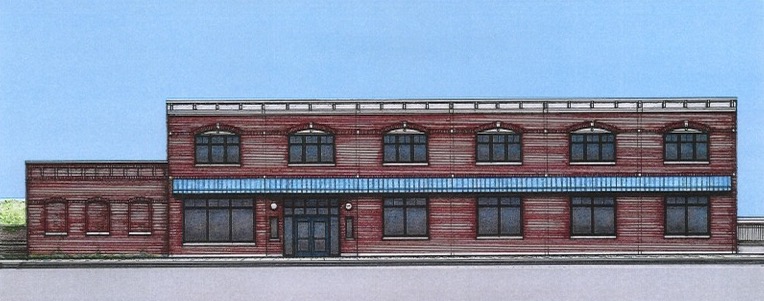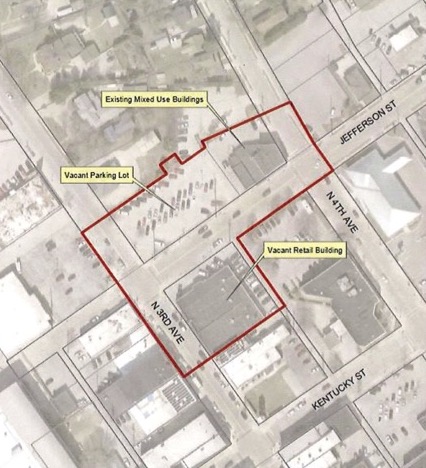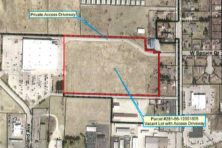Sturgeon Bay on Its Way to TID #8
- Share
- Tweet
- Pin
- Share

Sturgeon Bay’s Plan Commission approved a resolution to recommend creating the city’s eighth tax increment district (TID) near the intersection of 3rd Avenue and Jefferson Street, following a public hearing March 15.
The Common Council will consider the recommendation during its April 4 meeting.
TID #8 is called for in a development agreement that Shirley Weese Young has with the city to build a music venue and school called Muse in the vacant lot where the Moeller’s Garage auto dealership once stood. The TID boundaries would include that lot and two other parcels, encompassing the lot to the east that Young also purchased where the former PIP Printing building is located, as well as the lot across the street with the former Door County Ace Hardware building.

“I think it will energize and bring more activity to our wonderful 3rd Avenue business district,” said city administrator Josh VanLieshout.
Commission members received a report on the district’s project plan and boundary from Adam Ruechel, a financial consultant with R.W. Baird. He said TID #8 would generate an estimated $1.9 million in property-tax increments that would primarily be used to pay the district’s debt service costs and project-development incentives.
The development agreement with Young calls for providing her with $900,000 in financial assistance in 15 annual payments of $60,000, which would be paid back with property taxes generated from the development.
Ruechel said that by the end of 2025, the city projects an increase in property value in TID #8 of about $4 million from the construction of the Muse building, with another $200,000 coming from other projects in the district.
He said the city would remain under 12% of its total equalized value in TIDs, as required by state law, with the creation of TID #8. The newest TID would have a base value of about $1.1 million before the new development, giving the city about $125.3 million of increment value for the TIDs, with total equalized value of around $1.224 billion.
Including the addition of TID #8, “you’re at 10.24%,” Ruechel said. “And that number [is anticipated] to go down because we are going to be closing [TID #1 in the Industrial Park] later on this year.”
The city’s Finance/Purchasing and Building Committee recommended March 14 to close TID #1, which would return more than $40 million in increment value to the general tax roll. The Common Council is slated to consider that recommendation April 4 to be able to file the district’s termination with the Wisconsin Department of Revenue by April 15.

A joint review board, composed of representatives from the various taxing entities where TID #8 would be located, must also approve creating the district. Following Common Council action on April 4, the joint review board is slated to consider giving TID #8 final approval April 13.
Based on today’s tax rates, figures Ruechel provided noted that of the projected $1.9 million in estimated tax increments TID #8 could generate from 2026 to 2043, more than $800,000 would be the portion the Sturgeon Bay School District wouldn’t receive during that time to pay for the TID’s debt service costs and project-development incentives.
Commission member Amy Stephens said the school district “always feels the pain” from the creation of a TID.
“That doesn’t get talked about enough on this end of things, but yeah, no wonder, because they bear the majority of the burden,” she said.
Ruechel said the additional property taxes won’t be realized unless development occurs.
“It’s either new residential, or it’s new commercial, [or] it’s new industrial [development], which in the end brings students to the school district,” he said.
Ruechel said the existing tax base at the time a TID is created remains in each taxing jurisdiction.
“All of the taxing jurisdictions get that,” he said. “It’s essentially the increment that is on top of that – that is what goes into the [TID]. You always have a baseline, so they don’t technically lose anything as far as the taxes, but they don’t get that new increment for however long you keep the district open.”
Reduced Setbacks Recommended
In a separate motion, the commission approved reduced street yard setbacks for the Muse building, which will be allowed to have a one-foot street yard setback along Jefferson Street and a five-foot setback for 3rd Avenue.
The five-foot street yard setback along 3rd Avenue would pertain only to the public-restroom portion of the building, with the main portion being 30 feet from 3rd Avenue.
The community development department’s staff report noted the setbacks sought for the Muse building are not out of character with the surrounding area, with most of the buildings along 3rd Avenue being about five feet from the right-of-way.
The minimum yard setbacks for parcels located in the Central Business (C-2) zoning district are 15 feet at the street, five feet on the sides and 25 feet at the rear, but the commission has the ability to authorize less street and side yard setbacks.





